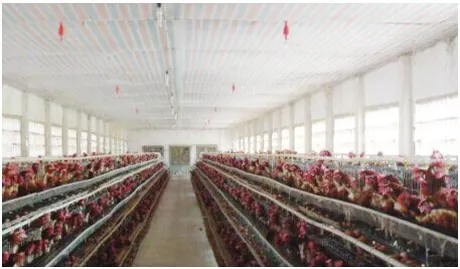PRODUCT CATEGORIES

In general, we have been focusing on winter and summer ventilation in both actual and theoretical terms. Both fall and spring temperatures are well-suited for growing chickens. Ventilation in the shed is easy to control, with little notice. There will be big problems. However, in fact, there is a great temperature difference between the outside of the seasons when the season is changed. If you do not attach importance to ventilation and management of flocks, it is easy to catch a cold and induce respiratory diseases. This is precisely the reason that infectious diseases such as infectious bronchitis, flu and Newcastle disease are easily infected in spring and autumn important reason. To this end, we should pay attention to the seasonal change of ventilation management.
A seasonal change prone to problems.

In the spring and autumn the day is warm, but not as hot as the summer, but cooler at night, but not as cold in winter, when we often think it is lukewarm, this season's ventilation should be the easiest. In fact, many chicken farms in the Spring and Autumn seasons conversion will occur in the following aspects, resulting in not be able to make good use of ventilation systems and induce flocks of respiratory diseases.
First of all, the number of air intakes on the side wall of the chicken coop is not enough so that an adequate transitional ventilation system can not be satisfied. Secondly, the transitional ventilation system should still be adopted and converted to a longitudinal ventilation system, resulting in over-ventilation of the chickens. Longitudinal air intakes, then, have poor containment performance when closed, so that a vertical ventilation system is used during the day and a minimum ventilation system can not be used during the colder periods at night, resulting in poor air quality in the room. In addition the transitional ventilation system can not be completely automatic control system, there are many random issues affect the ventilation effect.
2 minimum ventilation system
When the temperature in the chicken coop is at or below the set temperature, we turn on some of the air inlets, and the operation of the fan is controlled by the timer, so only the timing cycle is set to meet the needs of the flock to provide a good air quality. The air inlet of the side wall is controlled by the negative pressure, and the air flow reaches the middle of the roof of the chicken coop, which not only can fully utilize the roof heat but also can prevent the cold air from directly blowing on the chicken, and meanwhile, the heating system can be turned on.
When using the minimum ventilation system, the longitudinal air inlet should be sealed tightly. If the longitudinal air inlet can not be properly closed, the minimum ventilation system will not work well. Therefore, the use of vertical ventilation during high temperatures during the day, while the temperature becomes low at night need to use the minimum ventilation system, be sure to seal the longitudinal longitudinal inlet. When the chicken house temperature is higher than the set temperature, the fan is no longer controlled by the clock, but continuous operation, the transitional period of ventilation.
3 transitional ventilation system
Transitional ventilation, between minimum and vertical ventilation, requires an increase in the number of side vents, combined with minimum and longitudinal ventilation fans, and air entering the house from the side vents, which allows more air to enter the house , There is no vertical ventilation of the air-cooled effect, to avoid stress in chickens. A transitional ventilation system that takes a long time before switching to vertical ventilation can be used.
Transition ventilation system is the chicken coop temperature is higher than the set temperature, open all the sidewall air inlet, the minimum ventilation system fan is no longer controlled by the clock, but continuous operation. That is, all the air intakes for the minimum ventilation system are open, and sometimes some of the longitudinally ventilated fans can be used. For example: If the vertical installation of 10 vertical fan house, the minimum ventilation fan continuous operation, when the temperature is higher than the set temperature 2 ℃ open all the minimum fan +1 vertical fan; when the temperature is high at 3 ℃ turn on the minimum fan +2 Taiwan longitudinal fan; when the temperature is high 3.5 ℃ open the minimum fan +3 longitudinal fan; when the temperature is high at 4 ℃ open the minimum fan +4 longitudinal fan; when the temperature is high 5 ℃ longitudinal ventilation system, then The minimum ventilation fan is off, the side wall air inlet is closed and the longitudinal air inlet is open.
4 transitional ventilation management
We know that when the temperature of the house is below the set temperature, the minimum ventilation system is used. Only when the temperature of the shed has been above the set temperature, the transitional ventilation can be used. At this moment, the air flow inside the house is increased and the flocks can easily lie on the ground. Therefore, we should judge according to the flock performance in the end to open several fans more reasonable. That is more need to observe the behavior of flocks, you can not just look at the temperature measured by the thermometer to manage the ventilation system.
If all the chickens are on their tummy and no one puffs in the mouth, the chickens feel the air is too cold. At this time, even if the temperature is higher than the set temperature, we should turn off one of the longitudinal fans until the chickens start to feel active . If more than 10% of the birds are puffing, indicating that the chickens may feel a bit too hot, a longitudinal fan should be turned on again to see if the chickens are more comfortable. Only after reaching the maximum transitional ventilation can ventilation be switched to longitudinal ventilation.
When the maximum transitional ventilation is reached, the chickens still show too much heat before they can switch to the longitudinal ventilation system. Do not convert to longitudinal ventilation only if the temperature measured by the thermometer has exceeded the standard, otherwise it will be converted into longitudinal ventilation prematurely. The chickens will be cold-shocked and catch cold, often showing unwillingness to move on the ground, ie, the activity deteriorates.
After each change of ventilation settings, as a manager should stay in the chicken coop, it is best to wait about 20 minutes, carefully observe the flock's activity is better, so as to determine if we set the ventilation more reasonable. However, it is very passive and undesirable for most managers to empirically tell their workers to adjust their ventilation systems at will without continuously observing the actual performance of flocks.
In the spring and autumn season during the day the temperature is higher, the general need for transitional ventilation or vertical ventilation, the evening temperature and then converted to the minimum ventilation, so back and forth to change the ventilation system, this time the chicken coop with automatic control is the best, and the actual production is very Less able to achieve automatic control. Therefore, the use of the minimum ventilation at night, it should be properly sealed vertical ventilation inlet, or the minimum ventilation can not run well. At the same time manage a fixed clock cycle time to ensure good air quality inside the house.
Some farms in the evening with plastic film to close the longitudinal inlet to the plastic again during the day and tear down, so that the longitudinal inlet can not be closed at night, the negative pressure will not reach the minimum ventilation requirements, into the homes The air may be blown directly to the ground, causing chill flocks and wet bedding and so on. Therefore, the longitudinal air inlet is best equipped with a switchboard that can be switched on and off at any time (the smaller the number of boards is, the better the sealing performance is). In this way, the air inlet can be sealed tightly and the minimum air inlet system can be operated normally.
(* Guarantee your email safe absolutely)